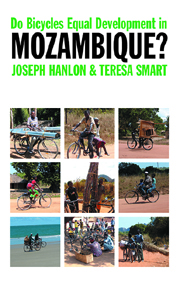Book contents
- Frontmatter
- Contents
- Acknowledgements
- The authors
- Money & measurements
- Abbreviations, acronyms & glossary
- Part I IS THERE DEVELOPMENT IN MOZAMBIQUE?
- Part II ACTORS & CONTEXT
- Part III ALTERNATIVES & THE DEVELOPMENTAL STATE
- 13 Questioning the cargo cult
- 14 Increase demand to kick-start the economy
- 15 Agriculture & the new role for the state
- 16 Finance & a development bank
- 17 The developmental state builds capitalism
- 18 Can Mozambique stop putting its hand out & become a development state?
- Appendix 1 Aid
- Appendix 2 Investment & other tables
- Bibliography
- Index
14 - Increase demand to kick-start the economy
from Part III - ALTERNATIVES & THE DEVELOPMENTAL STATE
Published online by Cambridge University Press: 05 April 2013
- Frontmatter
- Contents
- Acknowledgements
- The authors
- Money & measurements
- Abbreviations, acronyms & glossary
- Part I IS THERE DEVELOPMENT IN MOZAMBIQUE?
- Part II ACTORS & CONTEXT
- Part III ALTERNATIVES & THE DEVELOPMENTAL STATE
- 13 Questioning the cargo cult
- 14 Increase demand to kick-start the economy
- 15 Agriculture & the new role for the state
- 16 Finance & a development bank
- 17 The developmental state builds capitalism
- 18 Can Mozambique stop putting its hand out & become a development state?
- Appendix 1 Aid
- Appendix 2 Investment & other tables
- Bibliography
- Index
Summary
The poor are poor because they have no money. That simple statement goes a long way to explaining the economic problems in Mozambique. As Chapter 7 showed, the large majority of the rural poor are too poor to make even the most basic investments needed to help lift themselves out of poverty. Chapter 8 ended with a picture of Lichinga market, but it could have been in hundreds of different places, where market women sit behind tiny piles of vegetables or dried fish, which cost only pennies, but most people are too poor to buy. There are more bicycles, but one-third of them do not work; and people are too poor to repair them. In rural areas, the average cash income (excluding food grown for family consumption) is just $31 per person per year – 60ȼ, 30p, or 15 MT a week. That does not buy much in the market.
In the previous chapter we noted the UNCTAD view that ‘domestic demand makes the largest single contribution to economic growth’, and that making it easier to do business is no help when people do not have the money to buy. It seems obvious, then, that one way to kick-start the economy is to give people money that they can use to buy things. That will lead others to grow, make and sell more, triggering a local economic boom.
- Type
- Chapter
- Information
- Do Bicycles Equal Development in Mozambique? , pp. 154 - 160Publisher: Boydell & BrewerPrint publication year: 2008



